About Holes | ||||||
|
| |||||
Hole Definition Dialog Box
In Hole Definition dialog box, you can create any standard hole using various options:
Extension Tab
Clicking the Extension tab lets you access the type limits. You can also define the shape of the hole's end and direction of the hole.
Whatever hole you choose, you need to specify the bottom limit you want. There is a variety of limits:
 |
 |
 |
| Blind | Up to Next | Up to Last |
 |
 |
|
| Up to Plane | Up to Surface |
Limit
The Limit box is available if you set the Up to
Plane or Up to Surface option.
- If you want to use Up To Plane or Up To Surface , you can then define an offset between the limit plane (or surface) and the bottom of the hole. For more information, see Part Design User's Guide: Sketch-Based Features: Creating 'Up To Surface' Pads.
- If you use Up To Surface, you can select a face belonging to the current body only.
- The Up To
next limit is the first face the application detects
while extruding the profile, but this face must stops the whole
extrusion, not only a portion of it, and the hole goes thru
material.


Preview Result
Direction
By default, the application creates the hole normal to the sketch face. But you can also define a creation direction not normal to the face by clearing the Normal to surface check box and selecting an edge or a line.
Contextual commands creating the directions you need are available
from the Direction box:
- Create Line: for more information, see Generative Shape Design User's Guide: Creating Wireframe Geometry: Creating Lines..
- Create Plane: for more information, see Generative Shape Design User's Guide: Creating Wireframe Geometry: Creating Planes..
- X Axis: the X axis of the current coordinate system origin (0,0,0) becomes the direction.
- Y Axis: the Y axis of the current coordinate system origin (0,0,0) becomes the direction.
- Z Axis: the Z axis of the current coordinate system origin (0,0,0) becomes the direction.
If you create any of these elements, the application then displays the corresponding icon in front of the Direction box. Clicking this icon enables you to edit the element.
Bottom
To define the shape of the hole's end, you can choose between three
options:
- Flat : the hole is flat.
Even if the hole is of the Up To Surface or Up To Plane type, and even if an offset value is set from the target trimming element, the flat shape is never trimmed. The resulting geometry is therefore fully compliant with mechanical specifications.
- V-Bottom : the hole is pointed. You
just need to define how much it is pointed by specifying an angle
value.
Even if the hole is of the Up To Surface or Up To Plane type, and even if an offset value is set from the target trimming element, the V-bottom shape is never trimmed. The resulting geometry is therefore fully compliant with mechanical specifications.

- Trimmed:
this option can be used if the limit chosen for the hole is of the
'Up To Next, 'Up To Last', 'Up To Plane' or 'Up To Surface' type.
The plane or surface used as the limit, trims the hole's bottom.
Warning: The 'Up To Next' and 'Up To Last' options are only available in the Part Design workbench. In case Up To Surface is chosen, the selected trimming surface must cover the hole cross-section at the hole's bottom completely, otherwise the feature cannot be created.
Example of a Counterbored Hole With a V-bottom Trimmed by a Surface (Section View):
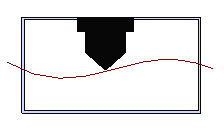
Example of a Counterbored Hole Trimmed by a Surface (Section View):
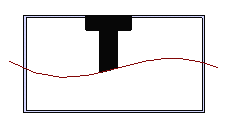
- The following contextual creation commands are available on the
BOTTOM text:
- Blind
- Up To Next
- Up To Last
- Up To Plane
- Up To Surface
- Flat bottom
- V bottom
Type Tab
Clicking the Type tab lets you access the type of hole you wish to create.
Various shapes of standard holes can be
created. These holes are:
- Simple
- Tapered
- Counterbored
- Countersunk
- Counterdrilled
If you choose to create a...
- Tapered hole: By default, the diameter value you specify
for a tapered hole (Extension tab) applies to the hole's
bottom. In case you prefer to specify the diameter value for the
hole's upper part, select Top in the Type
tab, and then just enter the desired value in the
Extension tab.
Note that for Blind and Up To Holes, computed radius values applying to the hole bottom may lead to twisted geometry or auto crossing on profile. The application then generates a tapered hole with the shape of a simple hole.
- Counterbored hole: the counterbore diameter must be greater than the hole diameter and the hole depth must be greater than the counterbore depth.
- Countersunk hole: the countersink diameter must be greater than the hole diameter and the countersink angle must be greater than 0 and less than 180 degrees.
- Counterdrilled hole: the counterdrill diameter must be greater than the hole diameter, the hole depth must be greater than the counter drill depth and the counterdrill angle must be greater than 0 and less than 180 degrees.
Thread Definition Tab
Clicking the Thread Definition tab lets you define the parameters of the threaded hole you want to create.
You can define a threaded hole by clicking the Thread Definition tab and selecting Threaded to access the parameters you need to define. Note that it is possible to thread tapered holes.
![]()
Hole Top
The hole top is trimmed in two ways depending on whether the hole is created in a positive body or not.
- If you create a hole in a positive body, that is a body containing
material, the application always trims the top of the hole using
the Up to Next option. In other words, the next face
encountered by the hole limits the hole.
In this example, the hole encounters a fillet placed above the face initially selected. The application redefines the hole's top onto the fillet.
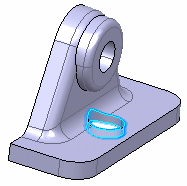
- If you create a hole in a negative body, that is a body containing
no material or a body with a negative feature as its first feature,
the application always trims the top of the hole using the Up
to Plane option and the plane used is the sketch plane.
Important: If you create a Counterbored type of hole with the Middle anchor point, the counterbored part is trimmed.
![]()
About Threads
You can define threads on a hole using Thread Definition tab.
You can also define a threaded hole by clicking the Thread Definition tab and select Threaded to access the parameters you need to define.
When a hole defined in Functional Modeling Part contains a thread specification, the corresponding thread representation is created in the drawing of the 3D shape. The thread representations in the drawing are generated on top view (3/4 of circle) and on lateral view.
![]()
About Locating Holes
You can easily locate the holes on body.
To locate holes, keep in mind that:
- The area you click determines the location of the hole, but you can
drag the hole onto desired location during creation using the left
mouse button. If Grid
 is activated, you can use its properties.
is activated, you can use its properties.
- Selecting a circular face makes the hole concentric with this face.
However, the application creates no concentricity constraint.
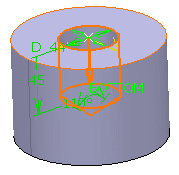
- Multi-selecting a circular edge and a face makes the hole
concentric to the circular edge. In this case, the application
creates a concentricity constraint.
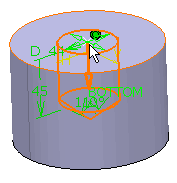
- Remember that the Sketcher workbench provides commands to constrain the point used for locating the hole. See Setting Constraints in the Sketcher User's Guide.
- Selecting a line and a face positions the hole along the line.

- Editing the line modifies the hole accordingly.
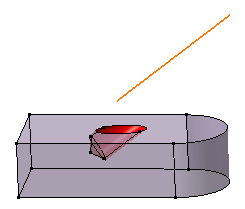
- Selecting an edge and a face allows the application to create one distance constraint. While creating the hole, you can double-click this constraint to edit its value.
![]()
Methodology
There is certain methodology you have to follow while creating a hole.
Editing hole center points may sometimes take a long time. Whenever your design includes several holes which center points need to be edited, we strongly recommend you define intermediate bodies on which you create the holes. Using intermediate bodies is a way of reducing the number of operations affected by changes. Once intermediate bodies are created, just assemble them to the 3D shape.




